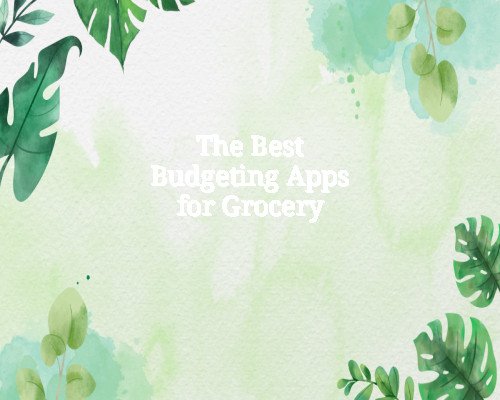The Best Budgeting Apps for Grocery
Stay on top of grocery expenses with these top budgeting apps that help you track spending, save money, and stick to your food budget effectively.
Why Budgeting for Groceries Matters
Groceries are one of the most flexible areas in a household budget, and often, they’re where overspending happens. With fluctuating prices, impulse buys, and inconsistent meal planning, managing grocery spending can quickly become chaotic. That’s why using budgeting apps tailored to grocery tracking is essential—they provide insights into your spending habits, help cut waste, and ensure you’re saving more each month.
What to Look for in a Grocery Budgeting App
When choosing the right app, consider the following features:
-
Expense Tracking: Categorization of purchases, particularly food and household items.
-
Budget Setting: Ability to create a grocery-specific spending limit.
-
Real-Time Syncing: Useful for families or roommates shopping together.
-
Receipt Scanning: Easy entry of grocery expenses.
-
Cashback or Coupon Integration: Opportunities to save while spending.
-
User-Friendly Interface: Clear design for easy navigation and quick updates.
Top Budgeting Apps for Grocery Management
1. YNAB (You Need A Budget)
YNAB is a highly popular app that gives every dollar a job. It’s ideal for meticulous budgeters who want to allocate funds in real time.
Key Features:
-
Create dedicated grocery budgets.
-
Track overspending and reassign funds.
-
Goal tracking for long-term savings.
-
Bank sync and manual entry.
Pros:
-
Detailed insights into spending.
-
Excellent for proactive planning.
-
Educational resources available.
Cons:
-
Subscription-based ($14.99/month or $99/year).
-
Slight learning curve for new users.
2. Mint
Mint offers a free, all-in-one budgeting platform with auto-categorization of spending and real-time bank syncing.
Key Features:
-
Automatic tracking of grocery expenses.
-
Budget alerts and overspending warnings.
-
Bill payment reminders and credit score monitoring.
Pros:
-
Completely free.
-
Customizable budgets for groceries.
-
Easy interface.
Cons:
-
Ads and third-party offers.
-
Less control over budget rule customization.
3. EveryDollar
Developed by Ramsey Solutions, EveryDollar focuses on zero-based budgeting, ideal for users who want to allocate all income to categories like groceries.
Key Features:
-
Manual transaction entry with grocery budget categories.
-
Clean and simple dashboard.
-
Real-time budget tracking in the premium version.
Pros:
-
Free basic version.
-
Great for Dave Ramsey followers.
Cons:
-
Free version lacks automatic transaction sync.
-
Premium costs $79.99/year.
4. Goodbudget
Goodbudget is an envelope-based budgeting app that digitally simulates the envelope system, great for grocery budgeting.
Key Features:
-
Allocate grocery money into a specific “envelope.”
-
Manual entry promotes conscious spending.
-
Available on web and mobile.
Pros:
-
Ideal for families with shared expenses.
-
Promotes intentionality in spending.
Cons:
-
Limited automation.
-
Manual entry may not appeal to everyone.
5. PocketGuard
PocketGuard connects to your bank accounts and gives a snapshot of what you can spend—making it perfect for staying within your grocery budget.
Key Features:
-
“In My Pocket” feature shows available funds after bills and goals.
-
Tracks subscriptions and bills.
-
Categorizes groceries automatically.
Pros:
-
Simple and intuitive.
-
Smart suggestions for saving.
Cons:
-
Limited customization.
-
Premium version required for advanced features.
6. Grocery Gadget Shopping List
While not a traditional budgeting app, Grocery Gadget helps you control grocery costs through detailed lists and tracking.
Key Features:
-
Create categorized grocery lists.
-
Sync with family members.
-
Track prices and store comparisons.
Pros:
-
Focused on grocery purchases.
-
Helpful for meal planning and price comparison.
Cons:
-
No broader financial budgeting features.
-
Dated interface.
7. Spendee
Spendee combines budgeting, expense tracking, and shared wallets, making it great for households or roommates tracking grocery spending together.
Key Features:
-
Create separate grocery wallets.
-
Invite other users to manage budgets.
-
Detailed charts and visuals.
Pros:
-
Great for collaborative budgeting.
-
Supports multiple currencies and bank sync.
Cons:
-
Some features locked behind a paywall.
-
Slightly less intuitive UI.
8. Zeta (For Couples and Families)
Zeta is designed with couples and families in mind, offering joint and individual expense tracking.
Key Features:
-
Grocery spending tracker for households.
-
Shared financial calendar and bill tracking.
-
Budget planner with savings goals.
Pros:
-
Great for managing shared grocery budgets.
-
Free with useful family-oriented features.
Cons:
-
Tailored more toward couples/families.
-
Not ideal for single users.
9. Receipt Hog
This app gamifies budgeting by rewarding users for uploading grocery receipts.
Key Features:
-
Snap photos of receipts for coins.
-
Get insights into your grocery habits.
-
Redeem coins for gift cards or cash.
Pros:
-
Adds a fun reward-based layer to grocery tracking.
-
Passive way to monitor expenses.
Cons:
-
Not a full budgeting tool.
-
Slow reward accumulation.
10. Flipp
Flipp is a deal-finding app that can help reduce grocery costs through flyer matching and digital coupons.
Key Features:
-
Browse local grocery flyers.
-
Add items to grocery list with lowest prices.
-
Coupon integration for savings.
Pros:
-
Helps stretch your grocery budget.
-
Free to use.
Cons:
-
Doesn’t track spending.
-
Best used alongside a true budgeting app.
How to Use Budgeting Apps Effectively for Groceries
Track All Grocery Purchases
Ensure you log every grocery expense—even small snack runs or emergency purchases. Accuracy builds better habits.
Create a Realistic Budget
Base your grocery limit on previous spending. Don’t aim too low or you’ll quickly get discouraged.
Use Lists and Meal Plans
Apps that support grocery lists and meal planning prevent impulse buying and wasted food.
Monitor Trends Monthly
Most apps provide monthly summaries. Review these to spot patterns, like overspending at a specific store or during weekends.
Collaborate with Family
If you live with others, use apps with syncing or shared wallets so everyone can contribute and stay accountable.
Best Free vs Paid Grocery Budgeting Apps
| App | Free Version | Paid Version Features |
|---|---|---|
| Mint | Yes | N/A |
| YNAB | No | Full access at $14.99/mo |
| EveryDollar | Yes | Sync and advanced features |
| Goodbudget | Yes | More envelopes, history |
| PocketGuard | Yes | Detailed insights, exporting |
| Spendee | Yes | Multiple wallets, premium graphs |
Final Tips for Staying on Budget
-
Shop with a list, not emotions.
-
Choose discount stores or bulk buying clubs.
-
Avoid shopping hungry.
-
Check store flyers via apps like Flipp before visiting.
-
Review your grocery budget weekly, not monthly.
Conclusion
Grocery budgeting apps are powerful tools that bring clarity, control, and cost savings to your food expenses. Whether you want detailed analytics with YNAB or a shared grocery plan with Goodbudget, there’s a solution that fits your lifestyle. By choosing the right app and using it consistently, you’ll make smarter decisions in the grocery aisle and see the savings add up every month.

